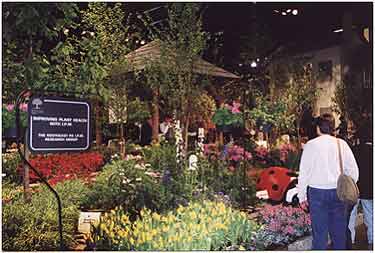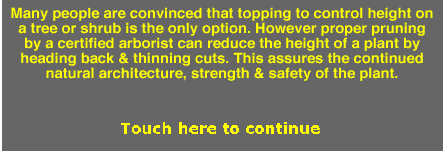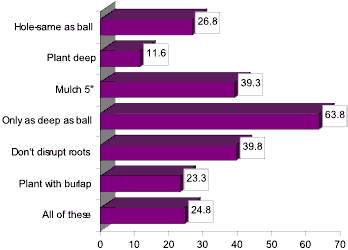April 2003 // Volume 41 // Number 2 // Research in Brief // 2RIB4
An Interactive Survey to Assess Consumer Knowledge About Landscape Plant Health Care and IPM Practices
Abstract
Employing a touch screen computer system with a survey
tool in the format of a quiz can be used to assess
consumer knowledge of integrated pest management and
plant health care practices. This article describes
the survey tool and environment the survey was administered
under and summarizes the results of the survey. Homeowner
knowledge of integrated pest management and plant
health care concepts was high, with greater than half
of the respondents choosing correct answers to the
survey questions. These findings suggest that Cooperative
Extension agents and specialists are positively affecting
home landscape management by influencing consumer
knowledge and practices.
Introduction
Plant Health Care (PHC) and Integrated Pest Management (IPM) are concepts that have become hallmarks of the Cooperative Extension effort to educate commercial and consumer clientele. The educational goals behind these two concepts are parallel and complementary. IPM employs monitoring of pest problems and recommends a combination of management tactics such as biological, chemical, cultural, and mechanical methods to reduce or maintain pest populations below damaging levels. PHC monitors plant health and focuses on prevention of plant problems through site analysis and plant selection before planting, proper planting procedures, deliberate and proper maintenance activities (Ball, 1994; Lloyd & Miller, 1997).
Cooperative Extension agents and specialists have long addressed issues of properly managing landscape plants to reduce pest activity and to assure healthy plants. The message is carried to both homeowners and commercial clientele in numerous forums, including organized education programs; newspaper, television, and radio pieces; clientele phone calls; and question and answer venues at local events.
However, quantifiable data on knowledge and practices consumers employ in their own landscapes relative to IPM and PHC concepts is seldom collected. The purposes for this report are to:
- Describe an interactive, touch screen computer system and quiz-based survey format.
- Summarize the results of a weeklong assessment of consumer understanding and implementation of IPM and PHC practices in their home landscape.
The Survey Site
The Philadelphia Flower Show is the largest indoor flower show in the world. Annually, 230,000 people visit the weeklong show orchestrated by the Pennsylvania Horticultural Society (PHS) in March. The show is built around a new theme each year that is interlaced through all the displays, exhibits, and competitions. Universities, colleges, schools, landscape architects, nurseries, florists, landscape construction firms, and supply companies design and construct displays to educate, entertain, and elicit future business from the attendees.
In 2001, Delaware Valley College, Horticulture Academy at Abraham Lincoln High School, Williamson Free School of Mechanical Trades, Walter Biddle Saul High School of Agricultural Sciences, U. S. Environmental Protection Agency Region III, Temple University, Penn State Cooperative Extension, Delaware Cooperative Extension, Rutgers Cooperative Extension, and the Southeast Pennsylvania IPM Research Group came together to create a display depicting and employing IPM and PHC practices (Figure 1).
Figure 1.
The "Improving Plant Health with
IPM" Display at the 2001 Philadelphia Flower
Show

Individual themes within the display area related to the concepts outlined in the Penn State Extension Publication Series "Creating Healthy Landscapes," which are available online at http://pubs.cas.psu.edu/landscapes.html. Each publication in the series addresses a specific topic in proper plant health care and pest management using a focused, descriptive, and easy-to-read format.
The display provided an ideal setting to assess the visitors on their understanding of the concepts of IPM and PHC and the practices they employ in their landscapes.
The Survey Tool
The site and participants offered several challenges relative to standard surveying techniques:
- Large number of visitors at the display at one time,
- Background noise and visual distractions,
- Participants' short attention spans, and
- Variability in participants' age, experience, and interest in gardening and the environment.
To address the site and participant limitations in a thought-provoking, educationally rewarding, and interactive manner, a quiz format for the survey was developed using multiple-choice answers. To address survey format issues, a computer-based quiz with a touch screen was chosen that would allow direct interaction with the respondent. This approach also maintained participant interest in the survey (Figures 2 and 3).
Figure 2.
Question 1 and Computer
Responses the Participants Received Based on Their
Answers to the Touch-Screen-Administered Survey
|
Which of the following features of your landscape are important to consider when choosing plants to purchase for your yard? Select all that apply.
Response for any answer except
"All of these" Response for "All of these" |
Figure 3.
Sample Screen Respondents Would See
After Incorrectly Answering a Question on Factors
Most Important in Deciding When and How to Prune


The survey consisted of 16 questions and was administered by Survey America and the TouchSource Group (Indianapolis, IN) on three touch-screen SurveyCenters™. The computer automatically recorded survey results as respondents touched the answers on screen. Data were collected continually during the hours of the show. This approach allowed participants to answer questions at their own pace.
The survey consisted of several parts, including questions regarding demographics, plant health care, and integrated pest management activities. Seven demographic questions addressed age, gender, home ownership, interest in gardening, interest in protecting the environment, use of professional landscape services, and location of residence.
The plant health care questions were multiple-choice questions allowing individual and multiple responses or the collective answer "all of these." Questions included site analysis concepts, planting practices, mulching, and pruning. Questions were:
- Which features of your landscape are important when choosing plants to purchase?
- What information should you know about the area you are landscaping to help you in choosing plants?
- Select all of the practices that you should do when planting a tree or shrub
- Can you identify all of the reasons for applying 2-3 inches of mulch around your landscape planting?
- What one factor would you consider most important when deciding when and how to prune?
Integrated pest management questions were multiple-choice questions and required a single answer response. Questions allowed answers of two types either "yes, no, and no opinion" or "always, sometimes, never, and no opinion." Questions focused on identifying, monitoring, and keeping records of plant problems. They included:
- As a general rule, do you identify the insect on your plants before deciding how to treat them?
- Do you regularly (once a week or so) walk through your yard to see how your plants are doing and whether there may be a pest problem?
- Can you identify pest damage without seeing the pest?
- Do you keep track of the pests and insect that you find around your plants and how you have treated them in the past?
Data Analysis and Survey Results
Survey America tabulated the data, conducted basic statistical analysis, and provided a report consisting of frequency and respondent percentage data for each question. The survey results were finalized within 2 weeks of the completion of the survey.
Of the show attendees, 2,158 participated in the survey. Participant responses were screened for completion and age. Partially completed responses and respondents 19 years of age and younger were removed from the survey population. Seven hundred-twenty eight eligible, completed, responses were obtained.
Survey Demographics
The average respondent age was 47 years, with the 36 to 50 year old group accounting for 44% of the population. Varlamoff, Florkowski, Jordan, Latimer, and Braman (2001) reported a similarly aged majority respondent pool to a phone survey on homeowner landscape practices in Georgia. The next largest respondent age group ranged in age from 51-60, 22% of the participants, followed by the 26-35 year old age group, 13% of the participants. A majority of the respondents were women (69%). Results from other consumer research have shown that the majority of survey participants tend to be female (Varlamoff et al., 2001; Kelley, Behe, Biernbaum, & Poff, 2001).
A majority of the respondents (76%) reported owning a single-family home as their primary residence, with 55% living within Pennsylvania, followed by New Jersey (21%). A majority (56%) never hired a professional landscape maintenance service, compared to 40% that have sometimes, frequently, or always hired firms. Respondents have a very strong to moderate interest in gardening (90%) and an interest in protecting the environment (87%).
Plant Health Care
The most correct answer to the question regarding important features to consider when purchasing landscape plants was "all of these." Respondents could also select any related answer, including:
- The amount of sun or shade the area receives each day
- Soil type (clay, loamy, or sandy) and amount of water held by the soil
- The soil pH
- The average temperatures recorded in the area during the year
- Exposure to the wind of the area
Fifty-eight percent of the respondents chose the answer "all of these" or selected all of the items before continuing. Among individual answers, 95% of respondents thought light levels at the planting site was most important, followed by soil type (85%), average temperature (74%), soil pH (74%), and exposure to the wind (70%).
Selecting proper activities when planting a tree or shrub also allowed multiple answers, but only one answer was correct, "plant only as deep as the root ball or pot." Among respondents, 49% chose the single correct answer, while 64% chose the correct answer along with several incorrect answers (Figure 4).
Figure 4.
The Percentage of Respondents Choosing
the Individual Answers to the Question "Select
all of the following that you should do when planting
a tree or shrub"

The correct reasons for applying 2-3 inches of mulch around a landscape planting included: weed reduction, reducing water loss from the soil, providing a slow release nutrient source, protecting plants from damage, and to keep plant looking good. "All of the above" was the most correct answer; however, selecting all of the individual correct answers was also an option. Overall, 49% of respondents chose all of the correct answers. Among individual answers, reducing water loss from the soil was most popular (94%), followed by weed reduction (91%), protecting plants (78%), slow release nutrient source (77%), and keeping plants well groomed (68%).
Reasons for pruning had three possible correct answers: "pruning to remove damage or diseased branches," "pruning to improve strength, structure and safety," and "thinning to improve air circulation." A majority of respondents chose from the possible correct answers (83%). Among these respondents, 47% chose improving strength, structure, and safety, followed by 32% choosing remove damaged or diseased branches. Choosing to prune because it is the season was selected by 7% of the respondents. Five percent of respondents also chose either pruning into formal shapes or topping because the tree is too tall.
Integrated Pest Management
Seventy-one percent of respondents identified insects on their plants before deciding to treat them. Similarly, 74% regularly monitored their landscape plants for problems. In the category of record keeping, a total of 72% kept regular or infrequent records of pests and insects they found and the treatment applied. Of these, 21% always kept records, while an equal percentage kept no records. On the ability to identify a problem without seeing a pest, only 8% claimed to always identify pest damage without seeing the pest, compared to 74% claiming to identify the damage some of the time.
Conclusion
The results of this survey were heartening in that when responding to plant health care and integrated pest management questions, nearly half or greater of the respondents chose the correct answers. While benchmark information pertaining to the set of questions asked of the respondents is hard to come by, results of the survey suggests that educational efforts are more likely having an impact on the perceptions and practices that consumers are employing in their landscapes. However, it is evident by the number of partial correct answers elicited through the survey that continued effort in educating home landscapers and consumers is still necessary.
The quiz format and the interactive computer system were effective tools for assessing knowledge under such challenging conditions. Conducting surveys involving similar tools under different environmental and site conditions could be helpful in assessing consumer understanding and implementation of plant health care and integrated pest management practices.
Acknowledgment
This project was partially funded by the Pennsylvania Horticultural Society and the Penn State University, Department of Entomology, IPM Program.
References
Ball, J. (1994). Plant health care and the public. Journal of Arboriculture, 20(1), 33-37.
Kelley, K., Behe, B. K., Biernbaum, J. A., & Poff, K. L. (2001). Consumer preference for edible-flower color, container size, and price. HortTechnology, 36(4), 801-804.
Lloyd, J., & Miller, F. (1997). Introduction to plant health care. In J. Lloyd (Ed.), Plant Health Care for Woody Plants. International Society of Arboriculture. Savoy, IL.
Varlamoff, S., Florkowski, W.J., Jordan, J.L., Latimer, J., & Braman, K. (2001). Georgia homeowner survey of landscape practices. HortTechnology, 11(2), 326-331.
